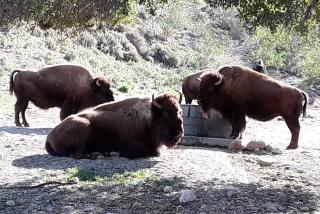Marines’ Buffalo May Need Some New Blood
- Share via
Camp Pendleton’s resident herd of 50 buffalo may need an infusion of new blood to prevent possible health and fertility problems caused by inbreeding over the last 14 years.
The herd, all of which are descended from seven bison donated by the San Diego Zoo in 1973, may have to be mated with new animals to protect the offspring, said Slader Buck, a civilian working for Camp Pendleton’s Natural Resources Office.
In May, the Marine Corps hired a Cardiff consulting firm, Southwest Research Associates, to conduct the first study of the animals’ habits and habitat since their release on the sprawling North County base.
“There were concerns expressed that many of the animals come from few parents. . . . Inbreeding allowed to go on unstudied will cause problems to show up in the animals,” said Buck, a wildlife biologist. “The purpose of the study is to get the data we need to make intelligent decisions regarding the herd.”
An estimated 60 million American bison once roamed the Great Plains before they were wiped out by hunters in the late 1800s. Now protected on public land and privately raised, the bison number about 100,000, said Ken Childs, a commercial bison breeder in Ramona.
The research team is watching the buffalo in the wild for 250 hours every three months, observing their eating, mating and migratory habits, said Rick van Schoik, principal investigator for
the Cardiff firm. The researchers have no plans to corral, tag or draw blood from the herd but may conduct those tests in the future, Van Schoik said.
So far the bison have shown no outward physical signs of inbreeding, such as infertility or unusually small size, said Van Schoik, who is leading the research project for the consulting firm.
But Childs, who was contacted by the consulting firm, said that disease or infertility caused by inbreeding is likely because the herd is descended from so few bison.
Childs, who also advised the Marines on the bison before they hired the consulting firm, said that the researchers will never be sure the animals are healthy unless they corral them and draw blood for genetic tests.
“If they don’t corral them, there’s no way to determine that if they don’t go out there with a tranquilizer gun--and that’s a tough thing to do,” Childs said. “If they’re not putting up a fence or gaining some kind of control, what’s the research for?”
By October, 1988, the researchers expect to have a summary of the herd’s history and an accurate count of the buffalo. Researchers will also report on the animals’ sexes, ages, seasonal movement and calving areas.
From that information, Buck’s office will make decisions on their future. The options range from doing nothing to removing or adding bulls to the herd, Buck said.
More to Read
Sign up for Essential California
The most important California stories and recommendations in your inbox every morning.
You may occasionally receive promotional content from the Los Angeles Times.













